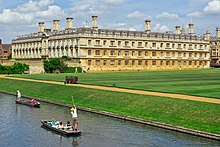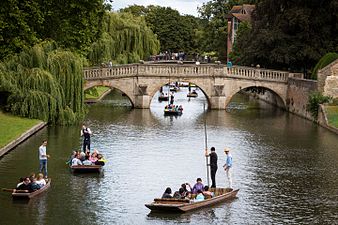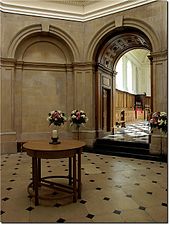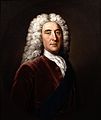| Clare College | |
|---|---|
| University of Cambridge | |
 Old Court, Clare College Old Court, Clare College | |
 Arms of Clare College: Arms of de Clare (Or, three chevrons gules) impaling de Burgh (Or, a cross gules) all within a bordure sable guttée d'or. Elizabeth de Clare's first husband was John de Burgh (1286–1313). Usually, the arms of the husband appear in the dexter half, the position of greater honour, here occupied by the arms of de Clare. This shield with its bordure of gouttes d'or (golden droplets) appears on the personal seal of Elizabeth de Clare. Arms of Clare College: Arms of de Clare (Or, three chevrons gules) impaling de Burgh (Or, a cross gules) all within a bordure sable guttée d'or. Elizabeth de Clare's first husband was John de Burgh (1286–1313). Usually, the arms of the husband appear in the dexter half, the position of greater honour, here occupied by the arms of de Clare. This shield with its bordure of gouttes d'or (golden droplets) appears on the personal seal of Elizabeth de Clare. | |
| Scarf colours: black, with two equally-spaced narrow yellow stripes | |
| Location | Trinity Lane (map) |
| Coordinates | 52°12′19″N 0°06′54″E / 52.2052°N 0.1150°E / 52.2052; 0.1150 (Clare College) |
| Abbreviation | CL |
| Established | 1326; 699 years ago (1326) |
| Named after | Elizabeth de Clare |
| Previous names | University Hall (1326-1338) Clare Hall (1338-1856) |
| Sister colleges | St Hugh's College, Oxford Oriel College, Oxford |
| Master | Loretta Minghella |
| Undergraduates | 484 (2022-23) |
| Postgraduates | 266 (2022-23) |
| Endowment | £166.8m (2023) |
| Visitor | Chancellors of the University ex officio |
| Website | www |
| UCS | ucs |
| MCR | mcr |
| Boat club | www |
| Map | |
  | |
Clare College is a constituent college of the University of Cambridge in Cambridge, England. The college was founded in 1326 as University Hall, making it the second-oldest surviving college of the University after Peterhouse. It was refounded in 1338 as Clare Hall by an endowment from Elizabeth de Clare, and took on its current name in 1856. Clare is famous for its chapel choir and for its gardens on the Backs (the rear of the colleges that overlook the River Cam). It is a registered charity.
History
The college was founded in 1326 by the university's chancellor, Richard Badew, and was originally named 'University Hall'. Providing maintenance for only two fellows, it soon hit financial hardship. In 1338, the college was refounded as 'Clare Hall' by an endowment from Elizabeth de Clare, a granddaughter of Edward I, which provided for twenty fellows and ten students.
The college was known as Clare Hall until 1856, when it changed its name to 'Clare College'. (A new 'Clare Hall' was founded by Clare College as a postgraduate institution in 1966.)
Women were accepted as undergraduates in 1972, one of the first three previously all-male colleges to do so.
Buildings
Old Court

Clare's Old Court, a Grade I listed building, was built between 1638 and 1715, with a long interruption for the English Civil War. The period spans the arrival of classicism into the mainstream of British architecture, such that its progress can be traced in the marked differences between the oldest wing to the north, which still has vaulting and other features in the unbroken tradition of English Gothic architecture, and the final southern block, which shows a fully articulated classic style.
The college's chapel was built in 1763 and designed by Sir James Burrough, the Master of neighbouring Caius College. Its altarpiece is Annunciation by Cipriani.
Old Court frames King's College Chapel in views from the Backs.

Clare Bridge
Main article: Clare College Bridge, CambridgeClare has a bridge over the River Cam and is the oldest of Cambridge's current bridges. It was built of stone in 1640 by Thomas Grumbold and restored in 1969, and is a Grade I listed building.
Fourteen stone balls decorate it, one of which has a missing section. A number of apocryphal stories circulate concerning this – one cited by members of the college is that the original builder of the bridge was not paid the full amount for his work and so removed the segment to balance the difference in payment. A more likely explanation is that a wedge of stone cemented into the ball as part of a repair job became loose and fell out.
Memorial Court
Clare Bridge connects Old Court to Memorial Court, which was designed by Giles Gilbert Scott and dedicated in 1926. The new court, west of Queen's Road, was conceived as a memorial to the Clare men who lost their lives in the First World War. The monumental arch which forms the entrance to the court accommodates a large bell and carries the names of Clare alumni who died in both world wars. Memorial Court is Grade II* listed,
Memorial Court was extended in the 1950s by the construction of Thirkill Court, and was later divided into two parts when the College's Forbes Mellon Library was constructed in the centre of Memorial Court; the new courtyard created in the west was renamed Ashby Court.
Lerner Court
A new court, Lerner Court, designed by van Heyningen and Haward Architects, was opened in January 2008. It occupies the last piece of undeveloped land in the central area of the College next to Memorial Court and houses a lecture theatre, catering, fellows offices, residential accommodation and a student laundry.
Castle Court
A detached area of student accommodation, Castle Court, is between Castle Street and Chesterton Lane, on Castle Hill, north of the city centre.
Gallery
-
 Old Court in Winter
Old Court in Winter
-
 Clare Bridge, over the River Cam
Clare Bridge, over the River Cam
-
 Clare Bridge's missing wedge
Clare Bridge's missing wedge
-
Inside the Great Hall
-
 The Scholars' Garden
The Scholars' Garden
-
 College chapel
College chapel
-
 Lerner Court
Lerner Court
-
Memorial Court
-
 Memorial Court viewed from Queen's Road
Memorial Court viewed from Queen's Road
-
 Clare College boathouse
Clare College boathouse
-
 Clare College chapel
Clare College chapel
Student life
In 1972 Clare College became one of the three male Cambridge colleges to admit female undergraduates (the other two being Churchill and King's).

Clare is known as a musical college in Cambridge. Its choir has performed all over the world. Clare College Music Society is well known, particularly the orchestra. As well as jazz and comedy nights, Clare is known for Clare Ents, a student night held every Friday in term time. The night is popular with students across the university and in the past it has hosted such acts as Tinie Tempah, Bombay Bicycle Club and Chase and Status.
The college's student newspaper is called Clareification.

Clare holds an annual May ball on the Monday of May Week in the middle of June.
Clare Boat Club
Clare Boat Club is the rowing club for current members of Clare College. There is a separate club, De Burgh Boat Club, for alumni. In 2012, Clare Boat Club had the highest membership relative to the size of its student body of any college-affiliated boat club in Cambridge, fielding six men's VIIIs in the May Bumps competition.
Academic performance
The undergraduates of Clare College were 12th in the 2024 Tompkins Table, based on degree results.
Clare was in the top ten colleges in the Tompkins Table from 2000 to 2005. However, their performance in the following years (2006–09) was poorer, leaving them in 12th in 2006 and 18th in 2009. Their 2010 performance (8th position) however showed an increase of 10 places over their previous year's performance, and in 2011 they reached fourth place. In 2018, Clare placed 16th out of 29 colleges recorded in the table. In 2019, it fell to 24th place. In 2022, it rose to 12th place.
Entrance into Clare College is competitive, with approximately five applicants per place. However, the high quality of applicants means that many of them are awarded places at other colleges through the Winter Pool. Of applicants in 2007, 151 were given offers by Clare, and a further 75 applicants were made offers at other Cambridge colleges.
People associated with Clare College
Main articles: List of alumni of Clare College, Cambridge and List of Masters of Clare College, Cambridge-
 Elizabeth de Clare, 11th Lady of Clare, writer, founder, and patron
Elizabeth de Clare, 11th Lady of Clare, writer, founder, and patron
-
 Kwame Anthony Appiah, philosopher, cultural theorist, and novelist
Kwame Anthony Appiah, philosopher, cultural theorist, and novelist
-
 Charles Cornwallis, 1st Marquess Cornwallis, British Army officer
Charles Cornwallis, 1st Marquess Cornwallis, British Army officer
-
Sabine Baring-Gould, Anglican priest and novelist
-
 Sir Tim Hunt, biochemist and physiologist
Sir Tim Hunt, biochemist and physiologist
-
 Hugh Latimer, Bishop of Worcester, Oxford Martyr of Anglicanism
Hugh Latimer, Bishop of Worcester, Oxford Martyr of Anglicanism
-
 Thomas Pelham-Holles, 1st Duke of Newcastle, former Prime Minister of the United Kingdom
Thomas Pelham-Holles, 1st Duke of Newcastle, former Prime Minister of the United Kingdom
-
 John Rutter, musician, composer and conductor
John Rutter, musician, composer and conductor
-
 Thomas Townshend, 1st Viscount Sydney, former Home Secretary
Thomas Townshend, 1st Viscount Sydney, former Home Secretary
-
 Sir Andrew Wiles, mathematician, solved Fermat's Last Theorem
Sir Andrew Wiles, mathematician, solved Fermat's Last Theorem
-
 Rowan Williams, Baron Williams of Oystermouth, a Welsh Anglican bishop, theologian, and poet
Rowan Williams, Baron Williams of Oystermouth, a Welsh Anglican bishop, theologian, and poet
-
 Henry Louis Gates Jr., American historian and filmmaker
Henry Louis Gates Jr., American historian and filmmaker
-
 Sir David Attenborough, naturalist, historian, and broadcaster
Sir David Attenborough, naturalist, historian, and broadcaster
-
 Gillian Tett, financial journalist and author
Gillian Tett, financial journalist and author
-
 Duleepsinhji, cricketer and Indian public servant
Duleepsinhji, cricketer and Indian public servant
See also
- A Clare Benediction (1998), an anthem by John Rutter
- Category:Alumni of Clare College, Cambridge
- Category:Fellows of Clare College, Cambridge
- Listed buildings in Cambridge (west)
References
- University of Cambridge (6 March 2019). "Notice by the Editor". Cambridge University Reporter. 149 (Special No 5): 1. Retrieved 20 March 2019.
- "Financial Statements for the year ended 30 June 2023" (PDF). Clare College, Cambridge. Retrieved 12 September 2023.
- Clare College, Cambridge (11 October 2017). "Statutes of Clare College" (PDF). clare.cam.ac.uk. Archived (PDF) from the original on 29 April 2022. Retrieved 20 October 2022.
- Walker, Timea (19 January 2022). "Clare College". undergraduate.study.cam.ac.uk. Retrieved 2 November 2022.
- "CLARE COLLEGE CAMBRIDGE, registered charity no. 1137531". Charity Commission for England and Wales.
- "The colleges and halls: Clare College". A History of the County of Cambridge and the Isle of Ely. Vol. 3: The City and University of Cambridge. 1959. pp. 340–346. Retrieved 2 June 2010.
- ^ Tim Rawle (1993). Cambridge Architecture (2nd ed.). André Deutsch. p. 100. ISBN 0-233-98818-1.
- "Five decades after Cambridge colleges went co-ed, too little has changed". Financial Times. 31 August 2022. Retrieved 25 April 2023.
- Clark, John Willis (1886). "Burrough, James (1691-1764)" . Dictionary of National Biography. Vol. 07. pp. 444–445.
- "The Chapel and Choir - Clare College Cambridge". www.clare.cam.ac.uk. Retrieved 9 October 2021.
- Historic England. "Clare College, Clare Bridge (1125549)". National Heritage List for England. Retrieved 13 April 2017.
- Clare College Cambridge. "Memorial Court - Clare College Cambridge". Retrieved 13 September 2014.
- "Clare College, Cambridge - van Heyningen and Haward Architects". Archived from the original on 26 September 2013. Retrieved 13 September 2014.
- "Clare College Cambridge changes 'colony' name over slavery connotation". BBC News. 28 June 2022. Retrieved 9 October 2024.
- Rebecca Smithers (20 December 2005). "The pick of the bunch". The Guardian. Retrieved 13 September 2014.
- "Clare Ents". Clare Ents. Retrieved 2 April 2012.
- "University Rankings, University of Cambridge". The Times. 24 September 2024. Retrieved 24 September 2024.
- "Tompkins Table 2000-2007". mattmayer.com. Archived from the original on 1 August 2009.
- "Tompkins Table 2011". The Independent. 18 July 2011. Retrieved 2 April 2012.
- "Clare Statistics". Clare College, Cambridge.
